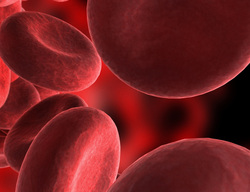Blood Clots/DVT

Blood Clots
Arteries carry blood away from the heart and veins carry blood back to it. Veins are thin and use valves which close after muscle contraction to allow blood to return back to the heart against gravity much like climbing a ladder. In the legs you have superficial veins and deep veins. Deep vein thrombosis (DVT) is a condition in which a blood clot (a blockage) forms in a deep vein. DVT is considered a medical emergency if these clots become mobile. If the clot (also known as a thrombus) breaks loose and travels through the bloodstream, it can lodge in the lung. This blockage in the lung, called a pulmonary embolism, can make it difficult to breathe and may even cause death. Blood clots in the thigh are more likely to cause a pulmonary embolism than those in the calf.
Signs and Symptoms:
If signs and symptoms present it is important to see a doctor for evaluation:
DVT can be difficult to diagnose, and should be taken to a medical specialist urgently. Other conditions such as a pulled muscle, an infection, a clot in a superficial vein (thrombophlebitis), a fracture, and arthritis can have similar symptoms.
If DVT is suspected, the doctor will likely send you to get a blood test, Doppler ultrasound, venogram, MRI, or angiogram.
Treatment of DVT
If the results of your test indicate that you do have a DVT treatment will be needed. This may include staying in the hospital or being placed on medications to allow for the dissolving of the blood clot or prevention of new blood clots in the future. Treatment may include:
If a DVT progresses it may travel to the lungs. We call this a pulmonary embolism. Signs of a pulmonary embolism may include:
Blood or vein conditions such as varicose veins, a history of DVT, or clotting disorders may contribute.
Heart disease, immobility, hormone replacement/birth control, trauma, smoking, cancer, infection, and chronic swelling of the legs all increase the risks of having a blood clot.
Arteries carry blood away from the heart and veins carry blood back to it. Veins are thin and use valves which close after muscle contraction to allow blood to return back to the heart against gravity much like climbing a ladder. In the legs you have superficial veins and deep veins. Deep vein thrombosis (DVT) is a condition in which a blood clot (a blockage) forms in a deep vein. DVT is considered a medical emergency if these clots become mobile. If the clot (also known as a thrombus) breaks loose and travels through the bloodstream, it can lodge in the lung. This blockage in the lung, called a pulmonary embolism, can make it difficult to breathe and may even cause death. Blood clots in the thigh are more likely to cause a pulmonary embolism than those in the calf.
Signs and Symptoms:
If signs and symptoms present it is important to see a doctor for evaluation:
- Swelling in the leg (usually one leg more than the other but can occur in both legs).
- Pain in the calf or thigh with pressure or with range of motion.
- Heat and redness of the leg.
DVT can be difficult to diagnose, and should be taken to a medical specialist urgently. Other conditions such as a pulled muscle, an infection, a clot in a superficial vein (thrombophlebitis), a fracture, and arthritis can have similar symptoms.
If DVT is suspected, the doctor will likely send you to get a blood test, Doppler ultrasound, venogram, MRI, or angiogram.
Treatment of DVT
If the results of your test indicate that you do have a DVT treatment will be needed. This may include staying in the hospital or being placed on medications to allow for the dissolving of the blood clot or prevention of new blood clots in the future. Treatment may include:
- A blood-thinning medication used to thin the blood.
- Wearing fitted compression stockings to encourage flow of blood against gravity.
- Surgery by a specialist.
If a DVT progresses it may travel to the lungs. We call this a pulmonary embolism. Signs of a pulmonary embolism may include:
- Shortness of breath
- Chest pain
- Coughing up blood
- A feeling of impending doom
Blood or vein conditions such as varicose veins, a history of DVT, or clotting disorders may contribute.
Heart disease, immobility, hormone replacement/birth control, trauma, smoking, cancer, infection, and chronic swelling of the legs all increase the risks of having a blood clot.